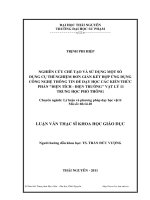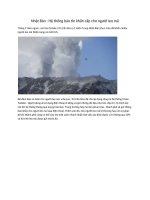Bài giảng Lý thuyết tín hiệu: Tín hiệu ngẫu nhiên - Võ Thị Thu Sương
Bạn đang xem bản rút gọn của tài liệu. Xem và tải ngay bản đầy đủ của tài liệu tại đây (408.35 KB, 17 trang )
TÍN HIỆU NGẪU NHIÊN
Định nghĩa
Tín hiệu không đóan được trước khi nó xuất
hiện
Không thể mô tả bởi biểu thức tóan học
Được mô tả bằng lý thuyết xác xuất
Được gọi là “quá trình ngẫu nhiên”
Quá trình ngẫu nhiên gồm một số hữu hạn các biến
ngẫu nhiên
Ví dụ:
x (t ) 5 c o s ( 2 f c t ),
CuuDuongThanCong.com
w h e re
is ra n d o m
/>
1.5 Random Signals
1.5.1 Biến ngẫu nhiên X(A)
Biến ngẫu nhiên là một đại lượng thực mà trị của nó phụ
thuộc vào biến cố ngẫu nhiên. (để biến cố NN có thể được
mô tả một cách định lượng)
Ví du độ lệch của viên đạn so với mục tiêu là một đại lượng
phụ thuộc vào kết qủa của lần bắn.
Sự phụ thuộc này được được biểu diễn bởi quy luật xác
suất gọi chung là phân bố
Sự phân bố của biến NN được mô tả bởi hàm mật độ xác
suất PX(x).
1 . n o n -n e g a tiv e :
p X (x) 0
2 . n o r m a li z e d :
-
3 . e v e n t p r o b a b i li t y :
CuuDuongThanCong.com
p X ( x)dx 1
x2
P ( x1 X x 2 ) =
p X ( x )dx
x1
/>
Discrete pdf
p ( X xi )
has the same properties (change integration to summation)
Two important random variables and their pdf
1 . U n i f o r m r a n d o m v a r i a b le
c o n tin u o u s p X ( x )
d is c re te :
1
b a
, fo r a x b
1
p ( X xi )
M
, fo r X { x 0 , , x M 1}
2 . G a u s s i a n ( n o r m a l) r a n d o m v a r i a b le
p X (x)
CuuDuongThanCong.com
1
2 X
e
(xm
2
X
2
X
)
2
/>
Các thông số
1. m ean:
m X E{ X }
2
xp X ( x)dx
2
2 . v a ria n c e : X E { ( X m X ) } E { X
2
2
} mX
( v a r i a n c e = m e a n s q u a r e v a lu e - m e a n v a lu e s q u a r e )
Example:
Data bits are modeled as uniform random variable with two values
Symbols are modeled as uniform random variable with M values
Noise is modeled as Gaussian random variable with zero mean and
non-zero variance
CuuDuongThanCong.com
/>
1.5 Random Signals
event
time
1.5.2 Random process: X(A,t)
Là một hàm hai biến A, t time-domain signal waveform with
some random event
Usually written as X(t) by embedding A
Stationary random process
Average parameters do not depend on time
We consider stationary random process (signal) only
Can usually be described conveniently only by average parameters
1. m ean:
m
S ta tio n a ry
X
(t ) E { X (t )}
m
2 . a u t o c o r r e la t i o n ( s t a t i o n a r y c a s e ) :
CuuDuongThanCong.com
X
c o n s ta n t
R X ( ) E { X ( t ) X ( t ) }
/>
Example (Note: expectation/integration is conducted with
random variable, not t)
F i n d t h e m e a n a n d a u t o c o r r e la t i o n o f t h e r a n d o m p r o c e s s
x (t ) 5 c o s ( 2 f c t ), w h e re [0 , 2 ) is u n ifo rm ra n d o m .
S o lu t i o n :
m X E { x (t )}
x ( t ) f ( ) d
2
0
5 c o s( 2 fc t )
1
2
d 0
R X ( ) E { x ( t ) x ( t ) }
=
=
=
2
0
25
2
CuuDuongThanCong.com
x ( t ) x ( t ) f ( ) d
5 c o s ( 2 f c t ) 5 c o s ( 2 f c t 2 f c )
c o s ( 2 f c )
/>
1
2
d
1.5.2.3 Autocorrelation
Defined by matching of a signal
with a delayed version of itself
Measure how closely a signal
matches a shifted copy of itself
Is a function of delay , not time t
Note for figure:
Random process cos(2πfct+θ)
does not look like noise.
CuuDuongThanCong.com
/>
1.5.4 Power Spectral Density (PSD)
PSD is FT{autocorrelation}
IF T
Gx( f )
R x ( )
FT
The only way for frequency-domain
description of random signal (since
FT{x(t)} does not exist)
E x a m p le : F o r R x ( )
25
G x ( f ) F T { R x ( ) }
CuuDuongThanCong.com
2
c o s ( 2 f c ) , th e P S D is
25
4
[ ( f f c ) ( f f c ) ]
PSD of random
process
5cos(2πfct+θ)
/>
1.5.3 Parameters and their physical meaning
Mean & variance of random variable
Mean, autocorrelation, PSD of random process
1. m
X
: d c le v e l o f t h e s i g n a l
2
2. E{ X
3.
2
X
:
(t )} , R X (0 ),
- G X
a v e ra g e s ig n a l p o w e r
a v e ra g e p o w e r o f A C c o m p o n e n t
4 . F o r s i g n a ls w i t h o u t d c
i) m
( f )df :
X
0.
CuuDuongThanCong.com
ii)
2
X
z e r o - m e a n s i g n a ls
E{X
2
( t ) } e q u a ls a v e r a g e s i g n a l p o w e r
/>
1.5.5 Noise in communication
systems
AWGN: additive white Gaussian
noise
y(t)
x(t)
Additive: Noise is added (not
multiplied) to the signal
White: has constant PSD (equal
power for all frequency)
Gaussian: in every time-instant
(sampling instant), the noise is
Gaussian random variable
n(t)
S i g n a l m o d e l:
z e r o -m e a n A W G N n ( t ) p r o p e r t i e s :
i) P S D :
iii) p d f:
N
Gn ( f )
i i ) A u t o c o r r e la t i o n :
Noise is usually assumed zeromean AWGN
CuuDuongThanCong.com
y (t ) x (t ) n (t )
p(n)
0
w a tts /H z
2
N0
R n ( )
1
2
/>
e
2
n
2
2
2
( )
AWGN is a useful abstract noise model, although it is not
practical due to infinite power
In sampled process (discrete process), since δ(0)=1, we
still have
2
2
N0
E{X }
Discrete zero-mean AWGN: power &2variance are both N0/2
AWGN PSD &
Autocorrelation
CuuDuongThanCong.com
/>
1.6 Signal transmission through
linear systems
1.6.1 Deterministic signals
x(t)
X(f)
h(t) y(t)
H(f) Y(f)
y (t ) x (t ) * h (t )
x ( ) h ( t ) d
Y ( f ) X ( f )H ( f )
1.6.2 Random signals
No Y(f), X(f) exist! But can use PSD.
y (t ) h (t ) * x (t )
Gy( f ) Gx( f ) H ( f )
CuuDuongThanCong.com
x ( ) h ( t ) d
2
/>
1.6.3 Distortionless transmission & ideal filter
Distortionless transmission
Time-domain: only constant magnitude change & a delay
Frequency domain: constant magnitude response and linear phase
response
y (t ) K x (t t0 ),
Y ( f ) Ke
j 2 ft 0
Ideal filter: distortionless in passband
H ( f ) H ( f )e
j ( f )
where
X (f )
passband
K
H ( f )
s to p b a n d
0
( f ) 2 f t 0
Example. Input: AWGN with PSD G n ( f ) N 0 ./ 2 System: ideal
lowpass filter with unit magnitude response in passband fu.. Then
N 0 / 2 , fo r fu f fu
the output PSD is
Gy( f )
CuuDuongThanCong.com
0,
O th e rw is e
/>
Review: Analog
Communications
Amplitude modulation
4 main types, share similar modulator/demodulator
AM: amplitude modulation
DSB: double-sideband modulation
B.P.F
x(t)
cos 2f c t
SSB: single-sideband modulation
y(t)
modulator
VSB: vestigial sideband modulation
L.P
y(t)
Frequency modulation
(FM,PM)
CuuDuongThanCong.com
cos 2f c t
x(t)
demodulator
/>
1.7.1 DSB (Page 45-47,
Page 1022)
D S B s i g n a l:
xc (t ) x (t ) co s( 2 fc t )
D S B s p e c tru m :
Xc( f )
1
2
[ X ( f fc ) X ( f f c )]
x (t ), X ( f ) : m e s s a g e s ig n a l a n d s p e c tru m
D S B s ig n a l b a n d w ith = 2 * m e s s a g e b a n d w id t h
W D S B 2W x (t )
CuuDuongThanCong.com
/>
DSB demodulation
L.P
y(t)
y (t ) xc (t ) :
re c e iv e d s ig n a l
cos 2f c t
x(t)
demodulator
D e m o d u la t i o n o u t p u t i s :
xˆ ( t ) y ( t ) c o s ( 2 f c t )
lo w p a s s
= x (t ) co s( 2 fc t ) co s( 2 fc t )
lo w p a s s
= x (t )
1
2
=
[1 c o s ( 4 f c t ) ]
lo w p a s s
x (t )
DSB is2 a main digital passband modulation technique
CuuDuongThanCong.com
/>
Tín hiệu dừng
(t) là tín hiệu dừng chặt nếu:
E f ( t 1 ), ( t 2 ),... ( t n ) E f ( t 1 ), ( t 2 ),... ( t n )
(t) là tín hiệu dừng rộng nếu:
E t const
R t 1 , t 2 R ; t 1 t 2
(t) là tín hiệu Egodic nếu: (t) là TH dừng rộng và
R
CuuDuongThanCong.com
lim
T
1
2
T
t
*
t
dt
T
/>









